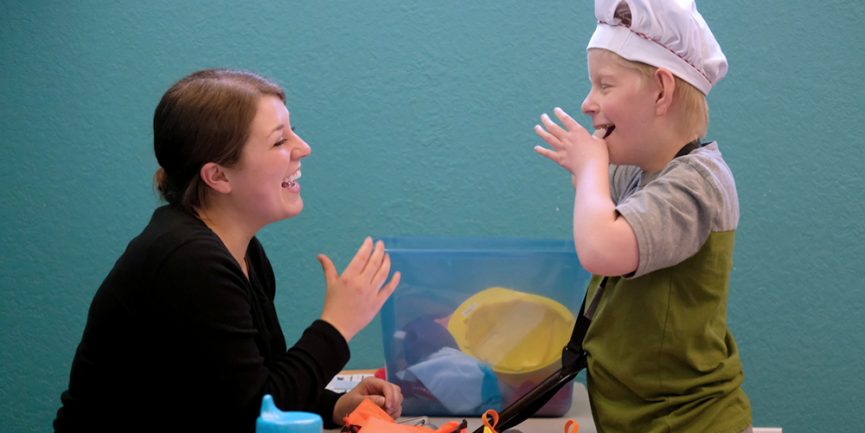Continuing Education Sign Language Occupational Therapy


Created by: Danielle Gage
MSU Speech Student
Common Misconceptions About Sign Language
- Sign language hinders my child's ability to speak: Research shows that sign language actually enhances a variety of speech and language skills necessary for foundational learning skills.
- My child has to have a hearing impairment in order to learn sign language: False. Sign language has been used to enhance language in a variety of populations, not just the deaf community, including children with limited expressive and receptive language skills, and children with autism to name only a few.
- Sign Language takes too much time: Begin teaching and introducing sign language slowly with a few signs here and there. Practice only those signs to gain consistency and enjoyment, and then continue to incorporate more signs. Sign language can easily be incorporated into daily activities, and there are a variety of free online resources and applications to aid in the learning and advancement of learning sign language.
- Sign Language will confuse a baby: sign language has actually been shown to bridge the gap between non-verbal communication (grunts, crying, and gestures) and speaking. Additionally, if sign language is introduced and taught early, research has shown that babies' brains will absorb new information and enhance actual brain development for natural development and speech and language development.
Importance of Sign Language
American Sign Language (ASL) is a beneficial support for your child's speech, language, and overall development. ASL has been proven not only to impact natural development, speech, and language, but also improve I.Q and enhance interactions with your child's environment. By utilizing sign language with your child, research has shown closer parent to baby bonds and more feelings of "being in tune" with each other. Additionally, sign language allows for fewer moments of distress for your child due to the ability to participate in pre/non-verbal communication, increased excitement and opportunities to communicate, increased attention and overall learning skills, as well as enhanced creativity and curiosity about the environment. ASL can serve as a bridge for the child that is bilingual and may be
learning a new language. In regards to speech and language development, ASL can provide for a smooth transition from gestures to speaking, improved vocabulary and confidence, enhanced use of adjectives and adverbs, empowered earlier reading and recognition of sight words, and increased overall expressive and receptive language skills. Overall, sign language can help your child to decrease frustrations and better enhance his/her abilities to perform in all environments.
How Can I Implement Sign Language at Home?
- Always model a sign with a verbal word
- Emphasize key concepts and vocabulary
- Incorporate all family members to further encourage sign language at home
Where Can I Go For More Information?
babysignlanguage.com
signingtime.com
babysigningtime.com
Sign Language Apps for Smart Phones or Tablets?
My Smart Hands Baby Sign Language Dictionary
ASL lite
Marlee Signs
SignShine
Signed Stories
What Does the Research Say?
- Research by Moeller, 2000 and Moeller, 2014 investigated ASL paired with spoken language instruction when it was used to emphasize key concepts and vocabulary. ASL was modeled throughout daily activities with family involvement and within a school environment. Results indicated that language development in children who were exposed to sign language had greater activation in both hemispheres of the brain, as well as multiple imprints of information on memory, which allows for greater generalization and memory of skills. It was also evidenced that familial connections and communication efficiency improved greatly.
- Research by Daniels, 1997 explored the relationships that existed between student academic outcomes and teachers proficiency with ASL. The study followed one teacher for 3 years as she grew in ASL proficiency and utilized it in the preschool classroom. Results indicated that as teacher's proficiency increased, so did student's average scores (6.8 average score for year one-19.70 average score for year two) Therefore, it can be concluded that ASL is a major contributor to language acquisition; especially receptive language skills.
- Research by Poizner, Kilma, & Bellugi, 1990) indicated that same area of the brain is activated when a person talks or uses signs. Therefore, teaching children with autism and other developmental disabilities to sign can actually accelerate speech development.
References:
Daniels, M. (1997). Teacher enrichment of prekindergarten curriculum with sign language. Journal of Research in Childhood Education,
12(1), 27-33.
Moeller, M. P. (2000). Early intervention and language development in children who are deaf and hard of hearing. Pediatrics, 106(3), e43-e43.
Edelson, PhD, S. (2014, January 1). Signed Speech or Simultaneous Communication. Retrieved from http://www.autism.com/advocacy_signing
graebnernareptund.blogspot.com
Source: https://childrenstherapycorner.com/2017/10/benefits-sign-language-2/
0 Response to "Continuing Education Sign Language Occupational Therapy"
Post a Comment